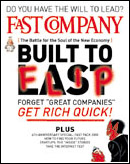Those are the three words you will find in a restaurant bill. Errors & Omissions Expected. Good acronym for trivia buffs.

E.O.E. These 3 words were uttered to me by an entrepreneur, whom I bought a cup of coffee. He was apologetic when I told him that’s not the way to do things and he should be building a company to scale and reach milestones–not built to flip. I narrated some tid-bits of the cover story done by Fast Company magazine which was prophetic and foretold the dot com meltdown which happened months after that article was published.
Agreed that there is more money than ever flowing in India in certain sectors and raising angel money is easier than before. However, chasing the sectors which are attracting a lot of attention is wrong way to bet things (His logic for betting on those sectors–It may be easier to raise money).
Unfortunately, a lot of entrepreneurs in India are reading too much into the Silicon Valley funding & exit fire hose, which makes sense only in the valley because of the reasons we know. India is still a parched land in terms of high-tech early stage money; only 5% of total PE/VC is in Angel + Series A + Series B. Furthermore, of that pool a very small percentage is for Pre-Series A deals. India’s early-stage money is FFI (Funnel funnily inverted or Fully f**** inside-out). Think about it. Do you still want to be an Exit Oriented Entrepreneur?
[Interestingly, @brij and I exchanged tweets on this topic yesterday morning related to @cdixon’s post]